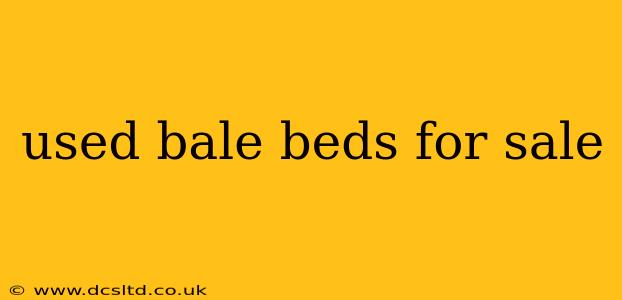Finding the right equipment for your farming or landscaping needs can be a challenge, especially when dealing with used machinery. Used bale beds, while offering significant cost savings compared to new ones, require careful consideration to ensure you're making a smart investment. This comprehensive guide will walk you through everything you need to know about finding and purchasing a used bale bed that fits your specific requirements.
What is a Bale Bed?
Before we delve into the specifics of buying used bale beds, let's define what they are. A bale bed is a specialized trailer or attachment designed to safely and efficiently transport hay, straw, or other types of baled agricultural products. They come in various sizes and configurations to accommodate different bale types and quantities, from small square bales to large round bales. The key features include robust construction, secure tie-down mechanisms, and often, sideboards to prevent shifting during transport.
Where to Find Used Bale Beds for Sale?
Several avenues exist for sourcing used bale beds. Consider these options:
- Online Marketplaces: Websites like eBay, Craigslist, and Facebook Marketplace often list used agricultural equipment, including bale beds. This provides a broad reach but requires diligent research and careful verification of the seller's legitimacy.
- Farm Auctions: Auctions frequently feature a wide array of used farm equipment, including bale beds. This can offer competitive pricing, but requires attendance and often involves bidding against other buyers.
- Agricultural Equipment Dealers: Many dealerships handle both new and used equipment. While prices might be slightly higher than private sales, they often provide warranties and service options.
- Local Farmers and Ranchers: Networking within your agricultural community might uncover privately owned bale beds for sale. This can lead to personalized service and potentially better deals.
What to Look for When Buying a Used Bale Bed?
Inspecting a used bale bed thoroughly before purchase is crucial to avoid costly repairs or replacements later on. Pay close attention to these aspects:
- Frame and Structure: Check for rust, dents, cracks, or significant wear and tear on the frame, axles, and suspension. A sturdy frame is essential for safe transport.
- Tires and Wheels: Inspect tires for wear and tear, ensuring sufficient tread depth and no significant damage. Check the wheels for alignment and any signs of damage.
- Hydraulics (if applicable): If the bale bed features hydraulic tilting or other hydraulic components, test their functionality thoroughly. Look for leaks or signs of malfunction.
- Tie-Down System: Ensure all tie-down straps, chains, or other securing mechanisms are in good working order and secure. A weak tie-down system risks damaging your cargo and potentially causing accidents.
- Deck Condition: Examine the bed for damage or wear and tear. Deep gouges or significant rotting can compromise the bed's structural integrity.
What are the different types of bale beds?
Bale beds are designed to accommodate different bale types, so understanding your needs is crucial before purchasing. Common types include beds for square bales (small or large), round bales, and even combination beds handling multiple bale types. Consider the dimensions and weight capacity to match your specific bale size and the number you typically transport.
How much does a used bale bed cost?
The cost of a used bale bed varies greatly depending on factors like size, condition, age, features, and location. Older, smaller beds may be available for a few thousand dollars, while larger, newer, or specialized beds could cost significantly more. Thorough research and comparison shopping are essential.
What is the average lifespan of a bale bed?
With proper maintenance and care, a well-built bale bed can last for many years. However, the lifespan significantly depends on usage frequency, storage conditions, and the quality of its construction. Regular inspections and timely repairs are crucial for extending its life.
What are some common problems with used bale beds?
Common issues include worn tires, damaged hydraulics (if equipped), rust, cracked welds, and faulty tie-down systems. A thorough pre-purchase inspection is paramount to identify and address these potential problems before buying.
By following these guidelines and conducting a careful inspection, you can increase your chances of finding a reliable and cost-effective used bale bed that meets your specific needs. Remember, a well-maintained used bale bed can be a valuable asset for years to come.
